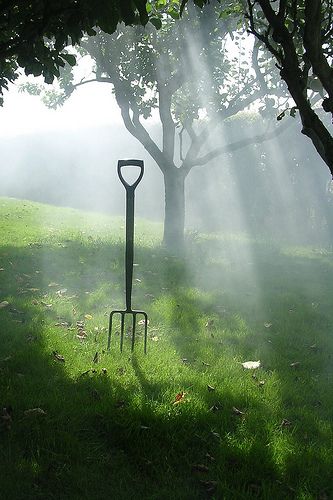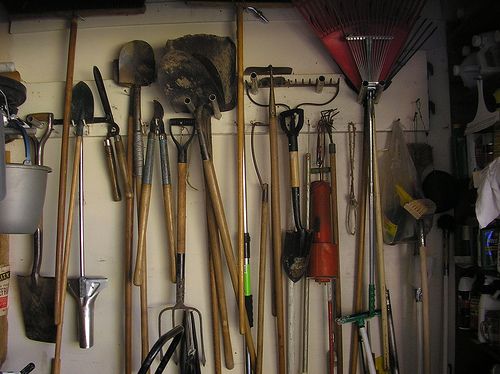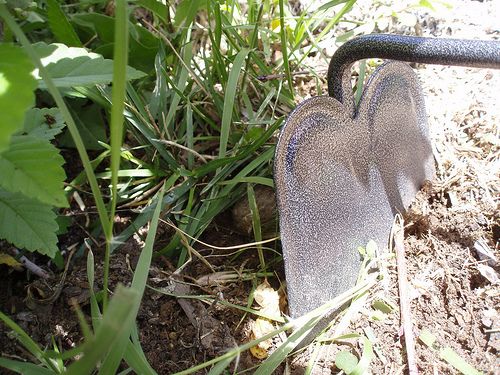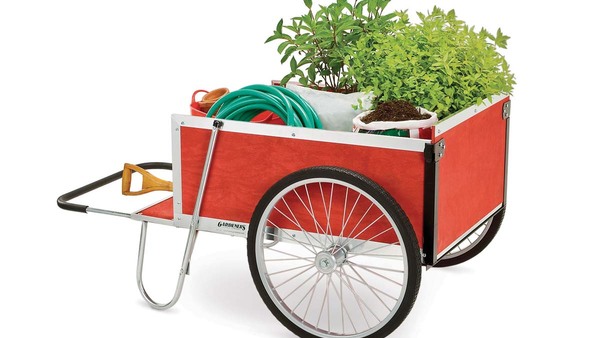
It’s easy to get away with a small handful of tools when you begin growing things in your backyard. Not a whole lot of tools are truly necessary, after all. But as time marches on and your gardening expands into new territory, you’ll begin wondering what else is out there that’ll make your venture easier. You start spotting handy-looking tools for simpler planting, weeding, and feeding.
Usually, it’s something in those gorgeous colored catalogs, or online gardening sites. And you begin to expand your tool shed repertoire. Many of them are truly a revelation, but some tend to reinvent the wheel. In any case, here’s a list of the basics of the tools of the trade and their functions.
1. Wheelbarrow—This has to be right up there with one of the handiest tools imaginable. A wheelbarrow hauls soil, rocks, sand, lumber, weeds, harvested food, etc. It basically does everything but fold the laundry. I guess you could get away without owning one, but why would you?
2. Round-point or spade shovel—I have searched far and wide and found that everyone has a different name for every shovel shape. And they don’t all agree. Instead of the official names, I’ll tell you what it looks like and you can name it, okay?
This is the shovel everyone seems to have in his/her garage or rusting outside behind the tool shed. It has a long handle, and the end of the shovel has sloping sides that gradually come to a point. These are handy for digging, planting trees and shrubs, cutting through sod, prying up rocks, dividing perennials, and digging trenches. This guy gets extra points if its metal shoulders are bent to create a foot rest for digging.
3. Square shovel—Like the round-point shovel, I give up on its “real” name—I promise, there are several. This is a long-handled shovel whose business end is square metal. It’s perfect for scooping things like soil, gravel, rocks, or sand and getting them from one place to another. It is also handy for mixing cement.
4. Long-handled hoe—This tool has to be one of my very favorite tools hands-down. Weeds tend to take over quickly, but if you just run a hoe in between the plants one or two times a week, it makes quick work of the sneaky little so-and-sos. Hoes show up differently, so the metal at the end may come in a variety of shapes.
There’s what I call the “original” hoe—the one that has a solid piece of flat rectangular metal on the end of it. This works just fine. But my personal favorite is the one that I like to call “the hoe of death”. It’s made with a sharp metal frame creating the rectangle. (I’ve heard people call it the “stirrup hoe.”) With this one, the thin metal lies flat into the soil, slides underneath the unsuspecting weed, and slices it off at the soil line.
5. Handheld hoe—This little guy is designed like the original hoe as well as the hoe of death, but it has a short handle so you can get up close and personal with your plants’ weedy enemies. What’s extra handy is that like using dental floss, you can get to those hard-to-reach places without disturbing the rest of the crop.
6. Garden fork—Forks can help cut into heavy soil and sometimes work much easier than a solid-bladed tool (say, a shovel). Garden forks loosen the soil, not lift it. They are great for mixing materials into the soil, turning compost piles, and harvesting root crops like carrots and potatoes. They’re also perfect for cleaning the bedding out of chicken houses and coops. Garden forks have a multitude of names, and from what I can tell, this is mostly due to differences in the fork, usually in the number or the weight.
English cultivating forks have thin, square tines, while the traditional fork tines are broad and flat. Both work well, but some people prefer the English version for tilling and aerating the soil. There are new types of forks being marketed everyday, so I honestly can’t keep up. I have one I use for everything.
7. Handheld cultivator—This tool works (and looks) like a garden fork but for little spaces.
8. Garden rake—There are (for the most part) two kinds of rakes. One is used to rake leaves, which I guess is handy but not a necessity. The one that I consider a must-have is the garden rake. It’s the one people leave lying around so that when you step on it the handle comes up and smacks you in the face.
If you happen to be one of those uber-cool people who have never experienced this phenomenon, the garden rake is the one with the long handle and short, curved metal tines on the end. It is great for spreading mulch, thinning your seedlings, leveling ground, creating raised beds, erasing footprints, and gathering debris. Oh, and I rake my leaves with it too.
9. Pruning shears or pruners—These are those handheld little jobbies you keep in your purse or in the glove box because you’ll need a pair on you at all times. Pruning shears are available in two styles. There’s the bypass version, which cuts like a pair of scissors. Then there’s the straight-blade type, where a blade closes down onto a plate. My favorite is the bypass pruners because the cut feels cleaner. But to each their own.
10. Knee cushion—This may not be something you need, but I sure as heck do. From a kneeling position, I need a 30-minute warning to get back up.
11. Lopping shears—You either seriously need these or you don’t need them at all. Lopping shears work like pruning shears whose trainer had slipped them a couple of steroids. They’re mainly for cutting big branches, dense shrubs, and the like. So if you’re just growing lettuce and some root crops, fugheddaboudit. But if you happen to be into fruit trees, buy two.
Last and quite possibly least:
| More about gardening tools … • Tool Housing and Husbandry • Tools for Working the Soil • Gardening Tools on the Cheap |
|
12. Garden gloves—Well, this is kind of obvious, right? If you want to protect your delicate hands from eventually looking like witches feet, may I gently guide you in a gloved direction? Gloves also protect against undesirable pathogens in the soil and offer protection from cuts and scrapes.
That said, I’m telling tell you right now that I don’t like—nor do I wear—gardening gloves. Nothing comes between me and the dirt, baby. That said, most normal gardeners appreciate what gloves can do for their hands and that they help you save money that might otherwise be spent on fancy lotions.
If I had to wear gloves (like if a doctor said I would die a horrible death if I didn’t), I would choose those edgy gloves that fit like a second layer of skin. They come in colors that make your girlish heart sing, and your hands can at least feel something. Kinda.
Fine Gardening Recommended Products

A.M. Leonard Deluxe Soil Knife & Leather Sheath Combo
Fine Gardening receives a commission for items purchased through links on this site, including Amazon Associates and other affiliate advertising programs.





















Comments
Hey, nice to see your efforts for your garden and plants. I also love gardening so much. When I started this in my backyard I have no idea which tools are to be used while gardening as that was my first experience. Then one my friend suggested me to visit https://backyardstyle.com/best-cordless-snow-blower/ this website. I paid my visit here on this website and this helped me a lot. Here on this website each and, every piece of information about these tools is available online, and which tools are best for your garden all information is available on a single page. Thank you so much for such help and information.
Log in or create an account to post a comment.
Sign up Log in